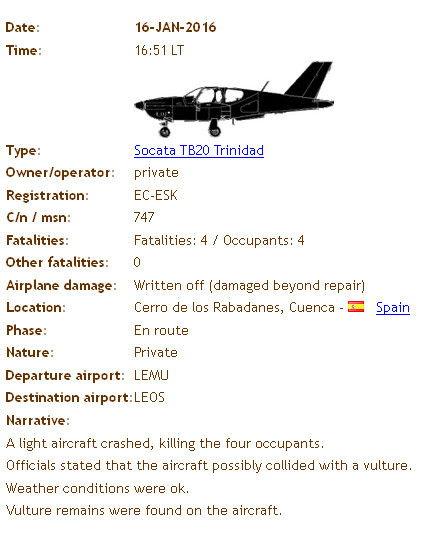I suppose it becomes relevant if they decide to write off an aircraft….so probably just standard questions
In some cases of minor leading edge damage, the installation of a STOL kit cuff is cheaper than the repair of the wing, and just leave the damage. A fellow I knew did this with his Cherokee, after he flew it through a corn field.
Looks like Piper had the foresight to design in a separate skin for the outboard panel. I imagine they did this for the inevitable damage due to taxiing into a post, etc. fortunately the bird hit right between ribs 28 and 31.
TB20, EC-ESK, 4x fatal, likely bird strike
http://aviation-safety.net/wikibase/wiki.php?id=183669

I saw some vultures in Spain at 9000ft; huge, maybe 2m wingspan.
Peter wrote:
I saw some vultures in Spain at 9000ft; huge, maybe 2m wingspan.
They are dangerous as hell and fly rather high. There have been reports of that species flying up to 20k ft in Asia and slightly lower over Spain. One of our Caravelles hit one of these things at around 15000 ft going into Almeria some 20 years ago. The engine was trash and they were lucky that it went past the cockpit windows. . Due to the fact that it went straight into the nacelle and didn’t hit anything else, we only had to change the engine. We were told at the time that Aviaco had almost lost a DC9 to one of those and a friend who flew with Spantax recounted a collision with one of them with a Coronado somewhere between Madrid and the South Coast. They can weigh up to 20 kgs and have a span of more than 3 meters.
That’s a tragic accident, and probably one where you have no chance. … The only chance woud be to duck under the glareshield when you see it coming … (Monday Morning Quarterback type of advice …:-()
In Mallorca, particularly over the mountains, we have these as well and that’s another good reason to spend your time looking outside rather than inside. And to consider your airspeed..
Unlike the plentiful seagulls and other birds, the vultures don’t duck away when they see an aircraft nearby. They just carry on with their business as if they are the king of the sky. And they are!
Aart,
what kind of altitudes do you see them at in Spain? I did read up on them a bit in the last 2 hours and there are almost unbelievable reports of up to 20k ft. Apparently they even found one of these nesting at over 6000 m in the Himalayas. Apparently they have a particular way to store more oxygen in their blood in order to fly that high…
The one which hit our engine in 1992 or thereabouts north of Almeria was at 15000 ft… I have to see if I can find pictures of the aftermath. We were quite aghast to see what it did to the engine, as opposed to the Spanish maintenance folks who seemed to have seen this kind of thing before. The front fan was almost totally gone, most of the compressor section was damaged beyond belief and I am glad I had no part of taking that engine apart… I seem to remember that there was one more incident with one of these near the Canarias but I am not sure if it was the same species. That airplane was shortly afterwards given back to the lessor and it was before my time.
I also noted that there are two species which both fly very high.
https://en.wikipedia.org/wiki/R%C3%BCppell’s_vulture
This one apparently got sighted even up at 37000 ft!
https://en.wikipedia.org/wiki/Cinereous_vulture
This one appears to be the one mostly seen in Spain at high altitude of between 15-20k ft. With 14 kgs life weight and over 3 m wing span, I suppose it can easily down a much larger airplane. Considering that the Canada Geese which brought Sully’s A320 down weigh about 1/3rd of that.
Mooney Driver,
The ones I have seen were typically some 500-1000 ft AGL. In Mallorca that means max 6000 MSL over the highest ground. I don’t recall encounters over the mainland of Spain. Peter above mentions 9000 MSL. One would expect these birds to be not more than say 1000 AGL, as they are looking for prey on the ground, and they are not migratory birds, right?